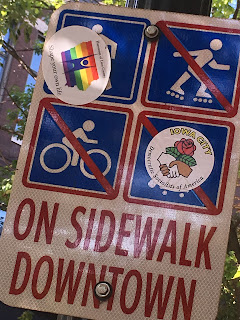No Skating, No Biking, No Liberty?
In his
chapter “Dreams and Documents,” Guimond establishes that photos, especially documentary
photos, hold the power to argue. Functioning iconoclastically, the symbols and
signs featured in each image interact within the photograph’s greater context
to create new meanings out of otherwise ordinary depictions— in the images Guimond
examines, meanings about the conceptualization of the “American Dream.” A
universally recognized yet completely abstract idea, the American Dream is
impossible to pin down. Conservative voices tend to argue that it is all about
opportunity and freedom, while the Liberal side generally believes the American
Dream is rooted in equality. Others, operating outside of this political
dichotomy, feel that this “dream” is actually a nightmarish failure to realize
any of those essential American ideals, or hold more complex views involving a
combination of these perspectives. The
variety of conceptualizations is explored further in another Guimond chapter,
“Signs of Hard Times,” and in Alinder’s “Art/History: Photographs of Japanese
American Incarceration in the Museum,” which both demonstrate just how many
different angles exist from which one might view this same subject—the American
Dream— depending on a photographer's gaze, a presenter’s intentions, or a viewer's understanding. The unique solipsism of the creator determines what meaning he or she infuses into each image, but the views and experiences of the viewer compound onto that another layer of perspective, which ultimately creates a highly personal viewing experience.
This
photograph, taken in the Iowa City Pedmall, captures two conflicting sides in
the debate on the meaning of the American Dream. As the sign angles down on the camera from above, there is a sense that this debate looms over American life, casting a shadow on the nation's operation. The sign takes up almost the entire frame of the photograph to emphasize exclusively the message it conveys, and remove the larger context. The intended purpose of this sign is to restrict
behavior by telling civilians what they cannot do. The colorful stickers covering up two
of those restrictive orders brightly protest that constraint in the Anglo-American
liberal tradition, reclaiming individual rights against an overbearing
authority. This small act of defiance says that the American Dream is about
freedom, echoing the Conservative platform. The content of the stickers,
however, lines up with Liberal-with-a-capital-L position. Democratic Socialism
is a purely Leftist idea, as is advocacy for LGBTQ+ rights, so the stickers themselves
argue that the American Dream is about equality. The image as a whole, then, is meant to conceptualize the American Dream as a complicated point of contention in the
struggle between opposing political forces, each side hoping to push America
towards its own version of that ideal. Individual viewers approach this image rooting for different teams, and therefore may take away different understandings of which side comes out on top in the story this photograph tells.

Comments
Post a Comment